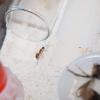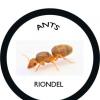Great news!
The Acanthomyops have a pupa!!! They have very few eggs left, and probably have around 35 larvae. As is usual in Lasius it seems, most are used for food, even if non-egg food is available... Once they get all their larvae pupated, I'll move them into a THA Lair. Interestingly, the pupa is smaller than that of the aphidicola, which is the opposite of what I was expecting. Perhaps hibernation, and simply existing for much longer led the aphidicola larvae to grow bigger.
I moved the aphidicola into a THA lair. Roughly half of that massive egg pile is now larvae, with lots more eggs to go. There is one pupa I see that looks like it's almost assuredly a male sadly, so I guess we'll see. I hope that is the only one, and not the reason why their larvae are larger. They are about the size of the larvae in my americanus colony, so I'm hoping not (speaking of them, they have like 700-800 eggs and hundreds of pupae, I should probably make an update  ). The lair seems to be a good fit for them, and it seems will last them for at least the rest of the year. I'm really happy with the formicarium, since it has two water towers, and Lasius love humidity.
). The lair seems to be a good fit for them, and it seems will last them for at least the rest of the year. I'm really happy with the formicarium, since it has two water towers, and Lasius love humidity.
The Poor Queen has laid more eggs, and is still fat. I expect them to get to a similar point as the queen with pupae, clearly they are the two best queens.
The other queens are just humming along, with some eggs seeming to be starting to hatch.
In other news, I'm now even more confident the Acanthomyops are not californicus. The fifth tooth, when counting from the mouth outwards, is extremely small in this species, whereas in californicus it is quite prominent. In terms of the teeth, it is rather close to claviger, but the antennae seem quite a bit too long, and the heads less wide. Sadly I cannot find images of coloradensis queens to see if that could be. I suppose another option is some type of hybrid, or an undescribed species.
That's it for now! My guess is that the aphidicola getting workers will be the next update. Or maybe I'll take some pictures.
Hi there! I went on a 6 month or so hiatus, in part due, and in part cause of the death of my colonies.
However, I went back to the Sierras, and restarted my collection, which is now as follows:
Aphaenogaster uinta, Camponotus vicinus, Camponotus modoc, Formica cf. aserva, Formica cf. micropthalma, Formica cf. manni, Formica subpolita, Formica cf. subaenescens, Lasius americanus, Manica invidia, Pogonomyrmex salinus, Pogonomyrmex sp. 1, Solenopsis validiuscula, & Solenopsis sp. 3 (new Sierra variant).

















